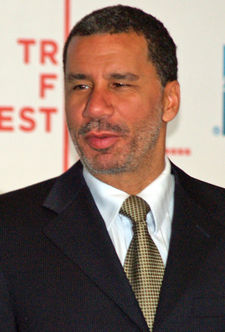List of Governors of New York
| Governor of New York |
|
|---|---|
 Governor's Standard |
|
| Style | The Honorable |
| Residence | New York State Executive Mansion |
| Term length | Four years, no term limit |
| Inaugural holder | George Clinton |
| Formation | July 30, 1777 |
| Deputy | Richard Ravitch |
| Salary | $179,000 (2009)[1] |
| Website | www.state.ny.us/governor/ |
The Governor of the State of New York is the head of the executive branch of New York's government and the commander-in-chief of the state's military forces.[2] The governor has a duty to enforce state laws, to convene the New York legislature,[2] the power to either approve or veto bills passed by the legislature,[3] and to grant pardons, except in cases of treason and impeachment.[4]
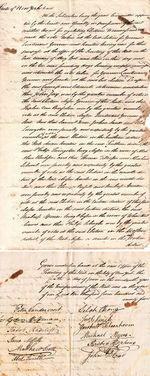
Fifty-five individuals have served as governor, four of whom served non-consecutive terms, totaling 59 distinct terms; the official numbering only lists each governor once, so there have officially been fifty-five governors. This numbering includes one acting governor: the lieutenant governor who filled the vacancy after the resignation of the governor, under the 1777 State Constitution.[5] The list does not include people who have acted as governor when the governor was out of state, such as Lt. Gov. Timothy L. Woodruff during Theodore Roosevelt's vice presidential campaign in 1900, or Acting Speaker of the New York State Assembly Moses M. Weinstein, who acted as governor for ten days in 1968 while the governor, the lieutenant governor, and the senate majority leader were out of the state, attending the Republican National Convention in Miami, Florida.[6]
Four men have become President of the United States after serving as Governor of New York: Martin Van Buren, Grover Cleveland, Theodore Roosevelt, and Franklin Delano Roosevelt.
The longest-serving governor was the first, George Clinton, who first took office on July 30, 1777, and served seven terms in two different periods, totaling just under 21 years in office. Charles Poletti had the shortest term, serving 29 days following the resignation of the previous governor in 1942. The current governor is David Paterson, who became governor on March 17, 2008 upon the resignation of Eliot Spitzer.
Contents |
Governors
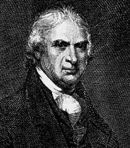
George Clinton, first Governor of New York, and 4th Vice President of the United States
.jpg)
John Jay, 2nd Governor of New York, and first Chief Justice of the United States
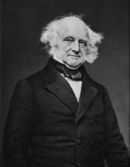
Martin Van Buren, 9th Governor of New York, and 8th President of the United States
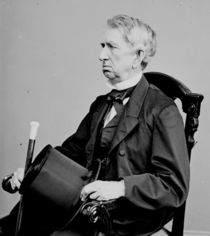
William H. Seward, 12th Governor of New York, and 24th U.S. Secretary of State
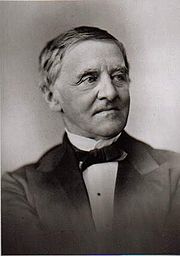
Samuel J. Tilden, 25th Governor of New York

Grover Cleveland, 28th Governor of New York, and 22nd and 24th President of the United States
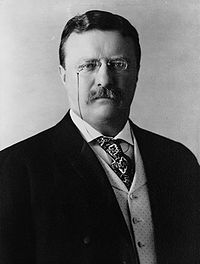
Theodore Roosevelt, 33rd Governor of New York, and 26th President of the United States
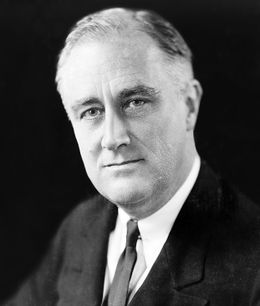
Franklin D. Roosevelt, 44th Governor of New York, and 32nd President of the United States
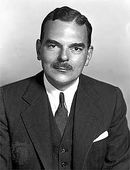
Thomas E. Dewey, 47th Governor of New York
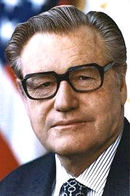
Nelson Rockefeller, 49th Governor of New York, and 41st Vice President of the United States
|
New York was one of the original thirteen colonies, and was admitted as a state on July 26, 1788. Prior to declaring its independence, New York was a colony of the Kingdom of Great Britain, which it in turn obtained from the Dutch as the colony of New Netherland; see the lists of colonial governors and of directors-general of New Netherland for the pre-statehood period.
The office of governor was established by the first New York State Constitution in 1777. The governor was originally for a term of three years,[7] though the constitution did not specify when the term began. A 1787 law set the start of the term at July 1.[8] The New York State Constitutional Convention of 1821 amended the state constitution, reducing the term of office to two years,[9] moving the election to November,[10] and moving the beginning and the end of the term to coincide with the calendar year.[11] An 1874 amendment extended the term of office back to three years,[12] but the 1894 constitution again reduced it to two years.[13] The most recent constitution of 1938 extended the term to the current four years.[14] There is no limit to the amount of consecutive terms a governor may serve.
The state constitution has provided since 1777 for the election of a lieutenant governor, who also acts as president of the state senate, to the same term (keeping the same term lengths as the governor throughout all the constitutional revisions). Originally, in the event of the death, resignation or impeachment of the governor, the lieutenant governor would become acting governor until the end of the yearly legislative term, the office being filled in a special election, if there was a remainder of the term.[15] Since the 1821 constitution, the lieutenant governor explicitly becomes governor upon such vacancy in the office and serves for the entire remainder of the term.[16] Should the office of lieutenant governor become vacant, the president pro tempore of the state senate.[note 1] performs all the duties of the lieutenant governor until the vacancy is filled either at the next gubernatorial election or by appointment.[note 2] Likewise, should both offices become vacant at the same time, the president pro tempore acts as governor, with the office of lieutenant governor remaining vacant. Should the presidency pro tempore be vacant too, or the incumbent unable to fulfill the duties, the speaker of the assembly is next in the line of succession.[17] The lieutenant governor is elected on the same ticket as the governor, since 1954 with a single joint vote cast for both offices, but is nominated separately.[18]
Democratic (25) Democratic-Republican (9) Federalist (1) Republican (18) Whig (5)
| # | Governor | Took office | Left office | Party | Lt. Governor | Terms [note 3] |
||
|---|---|---|---|---|---|---|---|---|
| 1 | George Clinton | July 30, 1777 | July 1, 1795 | Democratic- Republican |
Pierre Van Cortlandt | 6 [note 4] [note 5] |
||
| 2 | John Jay | July 1, 1795 | July 1, 1801 | Federalist | Stephen Van Rensselaer III | 2 | ||
| 1 | George Clinton | July 1, 1801 | July 1, 1804 | Democratic- Republican |
Jeremiah Van Rensselaer | 1 | ||
| 3 | Morgan Lewis | July 1, 1804 | July 1, 1807 | Democratic- Republican |
John Broome | 1 | ||
| 4 | Daniel D. Tompkins | July 1, 1807 | February 24, 1817 | Democratic- Republican |
John Broome | 3 1⁄2 [note 6] |
||
| John Tayler (Acting) | ||||||||
| DeWitt Clinton | ||||||||
| John Tayler | ||||||||
| 5 | John Tayler (Acting) [note 7] |
February 24, 1817 | July 1, 1817 | Democratic- Republican |
Philetus Swift (Acting) | 1⁄2 [note 8] |
||
| 6 | DeWitt Clinton | July 1, 1817 | December 31, 1822 | Democratic- Republican |
John Tayler | 2 [note 9] |
||
| 7 | Joseph C. Yates | January 1, 1823 | December 31, 1824 | Democratic- Republican |
Erastus Root | 1 [note 10] |
||
| 6 | DeWitt Clinton | January 1, 1825 | February 11, 1828 | Democratic- Republican |
James Tallmadge, Jr. | 1 1⁄2 [note 11] |
||
| Nathaniel Pitcher | ||||||||
| 8 | Nathaniel Pitcher | February 11, 1828 | December 31, 1828 | Democratic- Republican |
Peter R. Livingston (Acting) | 1⁄2 [note 12] |
||
| Charles Dayan (Acting) | ||||||||
| 9 | Martin Van Buren | January 1, 1829 | March 5, 1829 | Democratic | Enos T. Throop | 1⁄2 [note 13] |
||
| 10 | Enos T. Throop | March 5, 1829 | December 31, 1832 | Democratic | Charles Stebbins (Acting) | 1 1⁄2 [note 14] |
||
| William M. Oliver (Acting) | ||||||||
| Edward Philip Livingston | ||||||||
| 11 | William L. Marcy | January 1, 1833 | December 31, 1838 | Democratic | John Tracy | 3 | ||
| 12 | William H. Seward | January 1, 1839 | December 31, 1842 | Whig | Luther Bradish | 2 | ||
| 13 | William C. Bouck | January 1, 1843 | December 31, 1844 | Democratic | Daniel S. Dickinson | 1 | ||
| 14 | Silas Wright | January 1, 1845 | December 31, 1846 | Democratic | Addison Gardiner | 1 | ||
| 15 | John Young | January 1, 1847 | December 31, 1848 | Whig | Addison Gardiner | 1 | ||
| Albert Lester (Acting) | ||||||||
| Hamilton Fish | ||||||||
| 16 | Hamilton Fish | January 1, 1849 | December 31, 1850 | Whig | George Washington Patterson | 1 | ||
| 17 | Washington Hunt | January 1, 1851 | December 31, 1852 | Whig | Sanford E. Church | 1 | ||
| 18 | Horatio Seymour | January 1, 1853 | December 31, 1854 | Democratic | Sanford E. Church | 1 | ||
| 19 | Myron H. Clark | January 1, 1855 | December 31, 1856 | Whig (fusion) | Henry Jarvis Raymond | 1 | ||
| 20 | John Alsop King | January 1, 1857 | December 31, 1858 | Republican | Henry R. Selden | 1 | ||
| 21 | Edwin D. Morgan | January 1, 1859 | December 31, 1862 | Republican | Robert Campbell | 2 | ||
| 18 | Horatio Seymour | January 1, 1863 | December 31, 1864 | Democratic | David R. Floyd-Jones | 1 | ||
| 22 | Reuben Fenton | January 1, 1865 | December 31, 1868 | Union | Thomas G. Alvord | 2 | ||
| Stewart L. Woodford | ||||||||
| 23 | John Thompson Hoffman | January 1, 1869 | December 31, 1872 | Democratic | Allen C. Beach | 2 | ||
| 24 | John Adams Dix | January 1, 1873 | December 31, 1874 | Republican | John C. Robinson | 1 | ||
| 25 | Samuel J. Tilden | January 1, 1875 | December 31, 1876 | Democratic | William Dorsheimer | 1 | ||
| 26 | Lucius Robinson | January 1, 1877 | December 31, 1879 | Democratic | William Dorsheimer | 1 [note 15] |
||
| 27 | Alonzo B. Cornell | January 1, 1880 | December 31, 1882 | Republican | George Gilbert Hoskins | 1 | ||
| 28 | Grover Cleveland | January 1, 1883 | January 6, 1885 | Democratic | David B. Hill | 1⁄2 [note 16] |
||
| 29 | David B. Hill | January 6, 1885 | December 31, 1891 | Democratic | Dennis McCarthy (Acting) | 2 1⁄2 [note 14] |
||
| Edward F. Jones | ||||||||
| 30 | Roswell P. Flower | January 1, 1892 | December 31, 1894 | Democratic | William F. Sheehan | 1 | ||
| 31 | Levi P. Morton | January 1, 1895 | December 31, 1896 | Republican | Charles T. Saxton | 1 [note 17] |
||
| 32 | Frank S. Black | January 1, 1897 | December 31, 1898 | Republican | Timothy L. Woodruff | 1 | ||
| 33 | Theodore Roosevelt | January 1, 1899 | December 31, 1900 | Republican | Timothy L. Woodruff | 1 | ||
| 34 | Benjamin Barker Odell, Jr. | January 1, 1901 | December 31, 1904 | Republican | Timothy L. Woodruff | 2 | ||
| Frank W. Higgins | ||||||||
| 35 | Frank W. Higgins | January 1, 1905 | December 31, 1906 | Republican | M. Linn Bruce | 1 | ||
| John Raines (Acting) | ||||||||
| 36 | Charles Evans Hughes | January 1, 1907 | October 6, 1910 | Republican | Lewis Stuyvesant Chanler | 1 1⁄2 [note 18] |
||
| Horace White | ||||||||
| 37 | Horace White | October 6, 1910 | December 31, 1910 | Republican | George H. Cobb (Acting) | 1⁄2 [note 12] |
||
| 38 | John Alden Dix | January 1, 1911 | December 31, 1912 | Democratic | Thomas F. Conway | 1 | ||
| 39 | William Sulzer | January 1, 1913 | October 17, 1913 | Democratic | Martin H. Glynn | 1⁄2 [note 19] |
||
| 40 | Martin H. Glynn | October 17, 1913 | December 31, 1914 | Democratic | Robert F. Wagner (Acting) | 1⁄2 [note 12] |
||
| 41 | Charles S. Whitman | January 1, 1915 | December 31, 1918 | Republican | Edward Schoeneck | 2 | ||
| 42 | Al Smith | January 1, 1919 | December 31, 1920 | Democratic | Harry C. Walker | 1 | ||
| 43 | Nathan Lewis Miller | January 1, 1921 | December 31, 1922 | Republican | Jeremiah Wood | 1 | ||
| Clayton R. Lusk (Acting) | ||||||||
| 42 | Al Smith | January 1, 1923 | December 31, 1928 | Democratic | George R. Lunn | 3 | ||
| Seymour Lowman | ||||||||
| Edwin Corning | ||||||||
| 44 | Franklin D. Roosevelt | January 1, 1929 | December 31, 1932 | Democratic | Herbert H. Lehman | 2 | ||
| 45 | Herbert H. Lehman | January 1, 1933 | December 3, 1942 | Democratic | M. William Bray | 3 1⁄2 [note 20] [note 21] |
||
| Charles Poletti | ||||||||
| 46 | Charles Poletti | December 3, 1942 | December 31, 1942 | Democratic | Joe R. Hanley (Acting) | 1⁄2 [note 12] |
||
| 47 | Thomas Dewey | January 1, 1943 | December 31, 1954 | Republican | Thomas W. Wallace | 3 | ||
| Joe R. Hanley | ||||||||
| Frank C. Moore | ||||||||
| Arthur H. Wicks (Acting) | ||||||||
| Walter J. Mahoney (Acting) | ||||||||
| 48 | W. Averell Harriman | January 1, 1955 | December 31, 1958 | Democratic | George DeLuca | 1 | ||
| 49 | Nelson Rockefeller | January 1, 1959 | December 18, 1973 | Republican | Malcolm Wilson | 3 1⁄2 [note 22] |
||
| 50 | Malcolm Wilson | December 18, 1973 | December 31, 1974 | Republican | Warren M. Anderson (Acting) | 1⁄2 [note 12] |
||
| 51 | Hugh Carey | January 1, 1975 | December 31, 1982 | Democratic | Mary Anne Krupsak | 2 | ||
| Mario Cuomo | ||||||||
| 52 | Mario Cuomo | January 1, 1983 | December 31, 1994 | Democratic | Alfred DelBello | 3 | ||
| Warren M. Anderson (Acting) | ||||||||
| Stan Lundine | ||||||||
| 53 | George Pataki | January 1, 1995 | December 31, 2006 | Republican | Betsy McCaughey Ross | 3 | ||
| Mary O. Donohue | ||||||||
| 54 | Eliot Spitzer | January 1, 2007 | March 17, 2008 | Democratic | David Paterson | 1⁄2 [note 23] |
||
| 55 | David Paterson | March 17, 2008 | Incumbent | Democratic | Joseph Bruno (Acting) | 1⁄2 [note 12] [note 24] |
||
| Dean Skelos (Acting) | ||||||||
| Malcolm Smith (Acting) | ||||||||
| Pedro Espada (Acting) [note 25] |
||||||||
| Richard Ravitch (Contested) [note 26] |
||||||||
| Malcolm Smith (Acting) [note 27] |
||||||||
| Richard Ravitch [note 28] |
||||||||
Other high offices held
This is a table of congressional and other federal offices, and ranking diplomatic positions to foreign countries held by New York governors. All representatives and senators mentioned represented New York.
- * Denotes those offices for which the governor resigned the governorship.
- † Denotes those offices from which the governor resigned to take the governorship.
| Name | Gubernatorial term | U.S. Congress | Other offices held | Source | |
|---|---|---|---|---|---|
| House | Senate | ||||
| George Clinton | 1777–1795 1801–1804 |
Delegate to the Continental Congress, Vice President of the United States | [21] | ||
| John Jay | 1795–1801 | President of the Continental Congress, U.S. Secretary for Foreign Affairs, Minister to Spain, Chief Justice of the United States† | [22] | ||
| Daniel D. Tompkins | 1807–1817 | H | Vice President of the United States* | [23] | |
| DeWitt Clinton | 1817–1822 1825–1828 |
S | [24] | ||
| Nathaniel Pitcher | 1828 | H | [25] | ||
| Martin Van Buren | 1829 | S† | U.S. Secretary of State*, Minister to the United Kingdom, Vice President of the United States, President of the United States | [26] | |
| Enos T. Throop | 1829–1832 | H | [27] | ||
| William L. Marcy | 1833–1838 | S† | U.S. Secretary of War, U.S. Secretary of State | [28] | |
| William H. Seward | 1839–1842 | S | U.S. Secretary of State | [29] | |
| Silas Wright | 1845–1845 | H | S† | [30] | |
| John Young | 1847–1848 | H | [31] | ||
| Hamilton Fish | 1849–1850 | H | S | U.S. Secretary of State | [32] |
| Washington Hunt | 1851–1852 | H | [33] | ||
| John Alsop King | 1857–1858 | H | [34] | ||
| Edwin D. Morgan | 1859–1862 | S | [35] | ||
| Reuben Fenton | 1865–1868 | H† | S | [36] | |
| John Adams Dix | 1873–1874 | S | Minister to France, U.S. Secretary of the Treasury | [37] | |
| Grover Cleveland | 1883–1884 | President of the United States* | [38] | ||
| David B. Hill | 1885–1891 | S | [39] | ||
| Roswell P. Flower | 1892–1894 | H | [40] | ||
| Levi P. Morton | 1895–1896 | H | Minister to France, Vice President of the United States | [41] | |
| Frank S. Black | 1897–1898 | H† | [42] | ||
| Theodore Roosevelt | 1899–1900 | Vice President of the United States, President of the United States | [43] | ||
| Benjamin B. Odell, Jr. | 1901–1904 | H | [44] | ||
| Charles Evans Hughes | 1907–1910 | U.S. Secretary of State, Associate Justice of the Supreme Court*, Chief Justice of the United States. | |||
| William Sulzer | 1913 | H† | [45] | ||
| Martin H. Glynn | 1913–1914 | H | [46] | ||
| Franklin D. Roosevelt | 1929–1932 | President of the United States | [47] | ||
| Herbert H. Lehman | 1933–1942 | S | [48] | ||
| W. Averell Harriman | 1955–1958 | U.S. Secretary of Commerce, Ambassador to the United Kingdom, Ambassador to the Soviet Union | [49] | ||
| Nelson Rockefeller | 1959–1973 | Vice President of the United States | [50] | ||
| Hugh Carey | 1975–1982 | H† | [51] | ||
Living former governors
As of July 2010[update], four former governors are alive, the oldest being Hugh Carey (1975–1982, born 1919). The most recent governor to die was Charles Poletti (1942), on August 8, 2002.
| Name | Gubernatorial term | Date of birth |
|---|---|---|
| Hugh Carey | 1975–1982 | April 11, 1919 |
| Mario Cuomo | 1983–1994 | June 15, 1932 |
| George Pataki | 1995–2006 | June 24, 1945 |
| Eliot Spitzer | 2007–2008 | June 10, 1959 |
See also
- New York gubernatorial elections
Notes
- ↑ The state constitutions refer to this position as the "temporary president of the senate"
- ↑ On September 22, 2009, the New York Court of Appeals upheld the right of the governor to appoint a lieutenant governor to fill the vacancy.
- ↑ The fractional terms of some governors are not to be understood absolutely literally; rather, they are meant to show single terms during which multiple governors served, due to resignations, deaths and the like.
- ↑ There was no codified start for terms when Clinton took office; the date was set at July 1 in 1787, starting presumably in 1789.
- ↑ Many sources state the early governors took office on April 1; however, the elections were held lasting three days during the last week of April, with the oath of office being delivered on July 1.[19]
- ↑ Governor Tompkins resigned to be Vice President of the United States.
- ↑ Under the Constitution of 1777, Tayler was Acting Governor until the end of the legislative year.
- ↑ As lieutenant governor, acted as governor for unexpired term.
- ↑ The length and dates of terms were changed in 1821, during DeWitt Clinton's second term, which then ended on December 31, 1822 instead of July 1, 1823.
- ↑ As per the 1821 constitution, Governor Yates' term was the first to last two years instead of three.
- ↑ Died in office.
- ↑ 12.0 12.1 12.2 12.3 12.4 12.5 As lieutenant governor, filled unexpired term.
- ↑ Governor Van Buren Resigned to be United States Secretary of State.
- ↑ 14.0 14.1 As lieutenant governor, became governor for unexpired term, and was later elected in their own right.
- ↑ As per an 1874 amendment to the constitution (taking effect January 1, 1875), Governor Robinson's term was the first to last three years instead of two. As Governor Tilden had been elected prior to the amendment taking effect, he served the old two-year term.[20]
- ↑ Governor Cleveland resigned to be President of the United States.
- ↑ As per the 1894 constitution, Governor Morton's term was the first to last two years instead of three.
- ↑ Governor Hughes resigned to take seat as Associate Justice of the Supreme Court.
- ↑ Governor Sulzer was impeached and removed from office for campaign contribution fraud.
- ↑ As per the 1938 constitution, Governor Lehman's fourth term, commencing January 1, 1939, was the first scheduled to last four years instead of two.
- ↑ Governor Lehman resigned to be Director of Foreign Relief and Rehabilitation Operations at the U.S. Department of State.
- ↑ Governor Rockefeller resigned to devote himself to his Commission on Critical Choices for Americans.
- ↑ Governor Spitzer resigned due to a prostitution scandal.
- ↑ Governor Paterson's first term expires on December 31, 2010; he is not term limited.
- ↑ Espada is a Democrat, but combined with the Republicans a change of leadership which triggered the 2009 New York State Senate leadership crisis.
- ↑ Ravitch was appointed on July 8, 2009, but the appointment was contested in the courts. On August 20, the Appellate Division rejected the appointment, and Ravitch de facto vacated the office.
- ↑ Smith succeeded Espada on July 9 as Temporary President of the New York State Senate, and claimed to be Acting Lt. Gov. under the provisions of the New York State Constitution while the appointment of Ravitch was contested. Smith was de facto the sole occupant of the office from August 20 to September 22.
- ↑ On September 22, the New York Court of Appeals reversed the Appellate Division's ruling, and thus re-instated Ravitch to the lieutenant governorship, beginning de jure on July 8.
References
- General
- "Governors of New York". State of New York. http://www.ny.gov/governor/nygovs/index.html. Retrieved March 28, 2008.
- "Governors Database: New York". National Governors Association. National Governors Association. 2008. http://www.nga.org/portal/site/nga/menuitem.8fd3d12ab65b304f8a278110501010a0?submit=Submit&State=NY. Retrieved March 28, 2008.
- Jenkins, John Stilwell (1851). Lives of the Governors of the State of New York. Auburn N.Y.: Derby and Miller. p. 862. http://cdl.library.cornell.edu/cgi-bin/moa/moa-cgi?notisid=ANW1479.
- Constitutions
- "New York Constitution". New York Department of State. http://www.dos.state.ny.us/info/constitution.htm. Retrieved July 12, 2010.
- "1777 New York Constitution of New York". The Historical Society of the Courts of the State of New York. http://www.nycourts.gov/history/constitutions/1777_constitution.htm. Retrieved July 12, 2010.
- "1821 New York Constitution". The Historical Society of the Courts of the State of New York. http://www.courts.state.ny.us/history/constitutions/1821_constitution.htm. Retrieved July 12, 2010.
- "1894 New York Constitution". The Historical Society of the Courts of the State of New York. http://www.nycourts.gov/history/constitutions/1894_constitution.htm. Retrieved July 12, 2010.
- Specific
- ↑ "Payrolls and Pensions". SeeThroughNY. Empire Center For New York State Policy. http://www.seethroughny.net/PayrollsPensions/tabid/55/Payrolls/StatePayroll/tabid/69/Default.aspx?BRANCHID=1. Retrieved July 12, 2010.
- ↑ 2.0 2.1 New York Constitution article IV, § 3
- ↑ New York Constitution article IV, § 7
- ↑ New York Constitution article IV, § 4
- ↑ "Governors of New York". State of New York. http://www.ny.gov/governor/nygovs/index.html. Retrieved March 28, 2008.
- ↑ McFadden, Robert D. (December 3, 2007). "Moses Weinstein, 95, Legislator and Judge, Dies". The New York Times. http://www.nytimes.com/2007/12/03/nyregion/03weinstein.html?_r=1. Retrieved September 7, 2008.
- ↑ 1777 New York Constitution article XVIII
- ↑ "Governors of New York". New York Department of State. http://www.dos.state.ny.us/kidsroom/nysfacts/nysgovs.html. Retrieved March 28, 2008.
- ↑ 1821 New York Constitution article III, § 1
- ↑ 1821 New York Constitution article I, § 15
- ↑ 1821 New York Constitution article I, § 16
- ↑ John Joseph Lalor, ed (1883). "New York". Cyclopædia of Political Science, Political Economy, and the Political History of the United States. II. Chicago: Melbert B. Cary & Company. p. 1017. http://books.google.com/books?id=Xsk6AAAAIAAJ&pg=RA2-PA1017. Retrieved March 28, 2008.
- ↑ 1894 New York Constitution article IV, § 1
- ↑ New York Constitution article IV, § 1
- ↑ 1777 New York Constitution article X
- ↑ New York Constitution article IV § 5
- ↑ New York Constitution article IV § 6
- ↑ "Executive Branch of the Several States". The Green Papers. http://www.thegreenpapers.com/slg/executive.phtml. Retrieved March 28, 2008.
- ↑ Jenkins, John S. (1851). Lives of the Governors of the State of New York. Auburn: Derby and Miller. p. 121. http://books.google.com/?id=ZAxaNZ4i8BsC&printsec=titlepage#PPA121,M1. Retrieved March 28, 2008.
- ↑ Lincoln, Charles Z. (1906). The Constitutional History of New York. II. Rochester, New York: The Lawyers Co-Operative Publishing Company. p. 512. ISBN 0847694313. http://books.google.com/?id=cX84AAAAIAAJ&printsec=frontcover&dq=editions:04z6xtPOBaTQ1d1c-6SMRL#PPA512,M1. Retrieved March 28, 2008.
- ↑ "Clinton, George". Biographical Directory of the United States Congress. Clerk of the United States House of Representatives and Historian of the United States Senate. http://bioguide.congress.gov/scripts/biodisplay.pl?index=C000527.
- ↑ "John Jay". The Supreme Court Historical Society. http://www.supremecourthistory.org/history/supremecourthistory_history_chief_001jay.htm. Retrieved July 13, 2010.
- ↑ "Tompkins, Daniel D.". Biographical Directory of the United States Congress. Clerk of the United States House of Representatives and Historian of the United States Senate. http://bioguide.congress.gov/scripts/biodisplay.pl?index=T000306.
- ↑ "Clinton, DeWitt". Biographical Directory of the United States Congress. Clerk of the United States House of Representatives and Historian of the United States Senate. http://bioguide.congress.gov/scripts/biodisplay.pl?index=C000525.
- ↑ "Pitcher, Nathaniel". Biographical Directory of the United States Congress. Clerk of the United States House of Representatives and Historian of the United States Senate. http://bioguide.congress.gov/scripts/biodisplay.pl?index=P000367.
- ↑ "Martin, Van Buren". Biographical Directory of the United States Congress. Clerk of the United States House of Representatives and Historian of the United States Senate. http://bioguide.congress.gov/scripts/biodisplay.pl?index=V000009.
- ↑ "Throop, Enos Thompson". Biographical Directory of the United States Congress. Clerk of the United States House of Representatives and Historian of the United States Senate. http://bioguide.congress.gov/scripts/biodisplay.pl?index=T000247.
- ↑ "March, William Learned". Biographical Directory of the United States Congress. Clerk of the United States House of Representatives and Historian of the United States Senate. http://bioguide.congress.gov/scripts/biodisplay.pl?index=M000127.
- ↑ "Seward, William Henry". Biographical Directory of the United States Congress. Clerk of the United States House of Representatives and Historian of the United States Senate. http://bioguide.congress.gov/scripts/biodisplay.pl?index=S000261.
- ↑ "Wright, Silas Jr.". Biographical Directory of the United States Congress. Clerk of the United States House of Representatives and Historian of the United States Senate. http://bioguide.congress.gov/scripts/biodisplay.pl?index=W000770.
- ↑ "Young John". Biographical Directory of the United States Congress. Clerk of the United States House of Representatives and Historian of the United States Senate. http://bioguide.congress.gov/scripts/biodisplay.pl?index=Y000042.
- ↑ "Fish, Hamilton". Biographical Directory of the United States Congress. Clerk of the United States House of Representatives and Historian of the United States Senate. http://bioguide.congress.gov/scripts/biodisplay.pl?index=F000140.
- ↑ "Hunt, Washington". Biographical Directory of the United States Congress. Clerk of the United States House of Representatives and Historian of the United States Senate. http://bioguide.congress.gov/scripts/biodisplay.pl?index=H000978.
- ↑ "King, John Alsop". Biographical Directory of the United States Congress. Clerk of the United States House of Representatives and Historian of the United States Senate. http://bioguide.congress.gov/scripts/biodisplay.pl?index=K000205.
- ↑ "Morgan, Edwin Denison". Biographical Directory of the United States Congress. Clerk of the United States House of Representatives and Historian of the United States Senate. http://bioguide.congress.gov/scripts/biodisplay.pl?index=M000949.
- ↑ "Fenton, Reuben Eaton". Biographical Directory of the United States Congress. Clerk of the United States House of Representatives and Historian of the United States Senate. http://bioguide.congress.gov/scripts/biodisplay.pl?index=F000077.
- ↑ "Dix, John Adams". Biographical Directory of the United States Congress. Clerk of the United States House of Representatives and Historian of the United States Senate. http://bioguide.congress.gov/scripts/biodisplay.pl?index=D000365.
- ↑ "Grover Cleveland". The White House. http://www.whitehouse.gov/about/presidents/grovercleveland22. Retrieved July 12, 2010.
- ↑ "Hill, David Bennett". Biographical Directory of the United States Congress. Clerk of the United States House of Representatives and Historian of the United States Senate. http://bioguide.congress.gov/scripts/biodisplay.pl?index=H000590.
- ↑ "Flower, Roswell Pettibone". Biographical Directory of the United States Congress. Clerk of the United States House of Representatives and Historian of the United States Senate. http://bioguide.congress.gov/scripts/biodisplay.pl?index=F000217.
- ↑ "Morton, Levi Parsons". Biographical Directory of the United States Congress. Clerk of the United States House of Representatives and Historian of the United States Senate. http://bioguide.congress.gov/scripts/biodisplay.pl?index=M001018.
- ↑ "Black, Frank Swett". Biographical Directory of the United States Congress. Clerk of the United States House of Representatives and Historian of the United States Senate. http://bioguide.congress.gov/scripts/biodisplay.pl?index=B000496.
- ↑ "Theodore Roosevelt". The White House. http://www.whitehouse.gov/about/presidents/theodoreroosevelt. Retrieved July 12, 2010.
- ↑ "Odell, Benjamin Barker". Biographical Directory of the United States Congress. Clerk of the United States House of Representatives and Historian of the United States Senate. http://bioguide.congress.gov/scripts/biodisplay.pl?index=O000036.
- ↑ "Sulzer, William". Biographical Directory of the United States Congress. Clerk of the United States House of Representatives and Historian of the United States Senate. http://bioguide.congress.gov/scripts/biodisplay.pl?index=S001065.
- ↑ "Glynn, Martin Henry". Biographical Directory of the United States Congress. Clerk of the United States House of Representatives and Historian of the United States Senate. http://bioguide.congress.gov/scripts/biodisplay.pl?index=G000247.
- ↑ "Franklin D. Roosevelt". The White House. http://www.whitehouse.gov/about/presidents/franklindroosevelt. Retrieved July 12, 2008.
- ↑ "Lehman, Herbert Henry". Biographical Directory of the United States Congress. Clerk of the United States House of Representatives and Historian of the United States Senate. http://bioguide.congress.gov/scripts/biodisplay.pl?index=L000224.
- ↑ "Averell Harriman". HistoryCenteral.com. http://www.historycentral.com/bio/people/Harriman.html. Retrieved July 12, 2010.
- ↑ "Rockefeller, Nelson Aldrich". Biographical Directory of the United States Congress. Clerk of the United States House of Representatives and Historian of the United States Senate. http://bioguide.congress.gov/scripts/biodisplay.pl?index=r000363.
- ↑ "Carey, Hugh Leo". Biographical Directory of the United States Congress. Clerk of the United States House of Representatives and Historian of the United States Senate. http://bioguide.congress.gov/scripts/biodisplay.pl?index=C000143.
External links
|
||||||||||||||||||||||||
|
||||||||||||||
|
|||||||||||||||||
